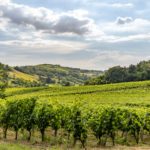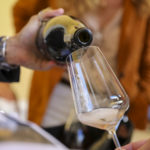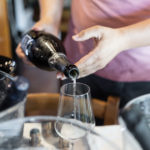Interview with Riccardo Binda, Director of Consorzio Tutela Vini Oltrepò Pavese

Riccardo Binda was born in Oltrepò Pavese in 1986 and, following classical studies, he graduated with flying colours in gastronomic sciences at the newly founded University of Gastronomic Sciences of Pollenzo in 2008. Two years later, following a semester at New Hampshire University, he took a master’s degree in the management and promotion of gastronomic heritage, again at Pollenzo. Next came a postgraduate degree at the Agricultural Institute of San Michele all’Adige, which is the top institute for wine studies in Italy, and after that he moved to Bolgheri in 2013, employed by the famous wine estate Tenuta Argentiera. In 2014, at the age of 28, Binda was entrusted with the management of the for Bolgheri DOC consortium and the many achievements during his mandate include the creation of the Bolgheri Sassicaia DOC appellation and the update of the Bolgheri Bianco DOC appellation. During ten long years of work, the number of producers belonging to the consortium grew from 36 to 74, representing 99% of Bolgheri’s total wine production. Thanks to this, Bolgheri became the appellation with the highest value per bottle in Italy, with an annual turnover of around €150,000,000 and seven million bottles produced. In 2020 the Live-Ex Power100 featured four Bolgheri wines in its top ten ranking, making this young and once unknown appellation a firm fixture in the world of fine wines.
In September 2024 Binda decided to bring his experience back to his homeland, accepting the position of director at the Oltrepò Pavese consortium with the aim of assisting the area in its shift towards a focus on the entire production chain, from vineyard to bottle, and to raising the denomination’s profile to premium level.
After 11 years as director of the Bolgheri wine consortium in Tuscany, how does it feel to return home to Lombardy as director of the Oltrepò Pavese consortium?
Bolgheri is an amazing place for any wine lover to live in and as well as this, by moving away, I left behind me a great many wonderful people and lots of friends. I am really happy to be back home however, because I’ve always been very attached to my roots and I’ve always known that sooner or later I’d be back here in Oltrepò Pavese. There’s a lot to do but there is great potential and it’s a real challenge.
What has changed already since you were appointed in September 2024 and which changes are planned for the coming months?
Among the various problems that we have to solve I think the biggest one is related to the Oltrepò Pavese’s lack of a definite identity. Don’t get me wrong, Oltrepò Pavese is home to a lot of unique wines, but there is no real focus. Also in Bordeaux for instance, they produce many different kinds of wine from Clairet to Sauternes, but everybody in the world relates that area to its great Cabernet-Merlot based reds. With this in mind, here in Oltrepò Pavese we must come to an agreement on which style of wine will be our ambassador. We can then work to adjust regulations and production protocols, which are currently quite confusing for consumers.

What plans are in place for developing wine tourism in Oltrepò Pavese and what are the greatest challenges?
Wine tourism is really underdeveloped here compared to other areas. First of all we have to work with the producers themselves to help them develop the tools they need to receive foreign visitors properly. Secondly, we must work with the local institutions to create a tourism network. The territory is large, it covers over 40 municipal areas, so one of our main challenges is to create a single shared strategy for such an extensive area.
There are strengths too of course, the first being the beauty of this area which has nothing to envy the hills of Chianti Classico or Langhe in terms of landscapes. For some reason, even many Italians have the idea that Oltrepò Pavese is a flat area but it’s actually quite the opposite – the highest point is in fact over 1,700m and most of the vineyards are at altitudes of between 200m and 600m asl. Another plus point is that the area is very easy to reach, especially from Milan. I believe that every wine lover passing through Milan should take at least one day to visit the Oltrepò Pavese wine area.

The wine tourism scene in Oltrepò Pavese is very different from that in Bolgheri – how will your previous experience help in your role here in Lombardy and how does it differ?
Although the two areas are very different, the target – the wine lover – is the same in both areas, with the same needs and preferences. One similarity between the two areas is the scarcity of accommodation for wine lovers. A major difference is the expectations of visitors: Oltrepò Pavese is one of Italy’s most historical wine producing areas but it’s still pretty much unknown as a destination. For this reason, I think the main challenge is to get people here. Once they come to Oltrepò Pavese it’s simpler as from that moment it’s all about discovering something new and unexpected, while in the case of Bolgheri people come knowing already that it’s a top-tier wine destination and so the challenge is to manage those high expectations.
Are you planning any wine-themed events in Oltrepò Pavese for 2025?
If so, could you tell us the dates?
We have recently held an important event focusing on our Pinot Nero Traditional Method and red wines (Oltrepò Pavese is actually Italy’s largest area for Pinot Nero production). Right now we are working on something new for the future but for the time being there is nothing that we can disclose.
Lastly, which is your favourite Oltrepò Pavese wine and food pairing?
I believe that our Salame di Varzi really is the best salami in the world, so definitely my preferred pairing is this tasty salami with a sparkling or semi-sparkling wine – either our Traditional Method Pinot Nero or the typical red Bonarda, a wine made with the local native Croatina grape.
